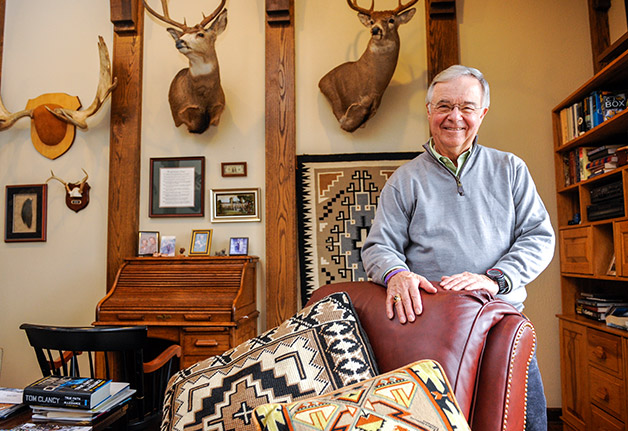When the first elk since 1737 wandered into South Carolina last year, Dr. Carl Walsh ’62 found himself at the center of the excitement. As past state chair and past regional chair for the Rocky Mountain Elk Foundation (RMEF), he answered media calls, consulted with others in wildlife preservation and shared his knowledge on the subject, educating the public not just on elk, but on the importance of habitat conservation.
“Historical documents indicate that there were perhaps 10 million elk in the U.S. in the late 1600s, but they were shot with reckless abandon and the number dropped to somewhere below 100,000,” says Walsh, who’s an avid outdoorsman and hunter as well as a retired family physician. “Most of the surviving elk were in little pockets deep in the Rocky Mountains; they were essentially gone east of the Mississippi River.”
Walsh and other volunteers with the RMEF have been trying to change that. By raising funds to purchase and secure land, RMEF volunteers have reintroduced elk back into North Carolina, Pennsylvania, Virginia, Tennessee and Kentucky. The young bull spotted throughout the northwestern tip of South Carolina migrated from North Carolina.
“Our main function is as a wildlife habitat conservation organization. We’re pushing 7 million acres of land that we’ve protected and conserved and enhanced,” says Walsh. “In 2000 we introduced 52 elk into the Cataloochee Valley of the Great Smoky Mountain National Park. Now there are about 300 in Western North Carolina, and they are extending their range. … We’re making progress, but we’ll never get back up to the 10 million because there are too many parking lots.”
Walsh became interested in elk and land conservation while he was in college.
“When I came through Wofford, everybody looked for summer employment, and we tried to work in different places to be exposed to different parts of the country,” says Walsh, who taught riflery and swimming at a boys’ camp in Maine before spending two summers as a waiter at Pahaska TeePee (Wild Bill Hickok’s historic hunting lodge). “I’ve always hunted, ever since I was a little boy, but working in Wyoming during college is when I became inspired by the Western hunting scene and elk preservation.”
According to Walsh, the RMEF partners with state and federal organizations, such as the National Forest Service, to acquire, protect and conserve land that offers optimal habitat for elk. The land is open to the public.
“People can hunt it, fish it, photograph it, camp on it or ride horses on it,” says Walsh. “It’s not just for elk. We all benefit.”
Walsh continues his preservation efforts with the future in mind. He remains active for his children and grandchildren: Lyn Walsh ’90 and Lauri Walsh Moore ’92, Lauri’s husband, Martin Moore ’92, and their three children, Ross (17), John Bailey (15) and Lyndsay (13), as well as the many young people who he feels need more time outdoors enjoying and exploring nature. When he’s not working on land conservation, Walsh also enjoys traveling, needlepoint and volunteering for Habitat for Humanity.
by Jo Ann Mitchell Brasington ’89
